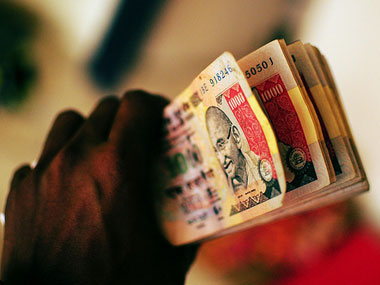Over the past six months, the rupee has been yo-yoing all over the place. After hitting a 2011 low of 54.30 against the US dollar in mid-December, the currency has climbed and then slipped again.
After recovering to 48.61 in early February on the back of strong foreign portfolio inflows, the local currency has again tumbled to new lows in May.On Tuesday morning, the rupee hit a fresh all-time low of 55.09 against the greenback, according to Reuters.
The volatility has not only increased the threat of ‘imported inflation’ (increasing prices of imports in local currency terms, which, in turn, raise prices in the local economy) but also cost the country any gains that might have accrued over cooling oil prices.
[caption id=“attachment_317262” align=“alignleft” width=“380” caption=“On Tuesday morning, the rupee hit a fresh all-time low of 55.09 against the greenback”]  [/caption]
Crude oil imports are India’s biggest import expense, accounting for one-third of the total value of annual imports.India’s oil imports between April 2011 and March 2012 totalled $156 billion, 48 percent higher from a year ago.A dip in the prices of crude, therefore, could go a long way in lowering the country’s record trade deficit - the gap between exports and imports. Assuming of course, a steady foreign exchange rate for the rupee.
But the rupee’s value has been anything but steady, which has caused any gains from declining crude prices to evaporate.
For example, in December 2011, the price of Brent crude, the global benchmark considered important for India, cooled to around $103 a barrel from $110. But perish the thought of the country making any gains from that - the rupee’s dive to 54.30 increased the cost of imports in local currency, keeping the value of oil imports high.
And the bad luck continued in February, when the rupee actually recovered some of its past losses to trade at 48.61 against the greenback. Even then, the country lost out because by then, oil prices had started rising above $115 again. In fact, by the end of the month, oil prices surged to $125 a barrel on renewed fears of supply disruptions caused by tensions in the Middle East. Overall, that meant India continued to spend a tidy sum on oil imports.
Come May and India still can’t seem to catch a break. Oil prices have come off significantly, down to $107 a barrel, and even now, India can’t benefit from lower oil prices. That’s because the currency has again plunged to new lows - at last glance, 55.09 – so that means once again, in local currency terms, India will have to pay relatively high prices for crude oil imports even though international prices have actually slipped.
Do we need any more proof of how deleterious such a volatile rupee is for the economy?


)
)
)
)
)
)
)
)
)



